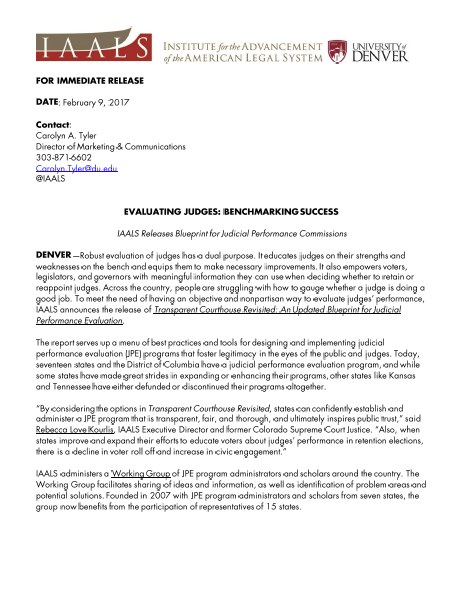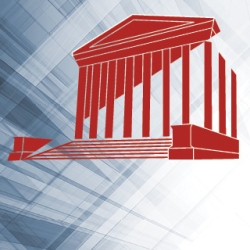Evaluating Judges: Benchmarking Success
IAALS Releases Blueprint for Judicial Performance Commissions
 Robust evaluation of judges has a dual purpose. It educates judges on their strengths and weaknesses on the bench and equips them to make necessary improvements. It also empowers voters, legislators, and governors with meaningful information they can use when deciding whether to retain or reappoint judges. Across the country, people are struggling with how to gauge whether a judge is doing a good job. To meet the need of having an objective and nonpartisan way to evaluate judges’ performance, IAALS announces the release of Transparent Courthouse Revisited: An Updated Blueprint for Judicial Performance Evaluation.
Robust evaluation of judges has a dual purpose. It educates judges on their strengths and weaknesses on the bench and equips them to make necessary improvements. It also empowers voters, legislators, and governors with meaningful information they can use when deciding whether to retain or reappoint judges. Across the country, people are struggling with how to gauge whether a judge is doing a good job. To meet the need of having an objective and nonpartisan way to evaluate judges’ performance, IAALS announces the release of Transparent Courthouse Revisited: An Updated Blueprint for Judicial Performance Evaluation.
 The report serves up a menu of best practices and tools for designing and implementing judicial performance evaluation (JPE) programs that foster legitimacy in the eyes of the public and judges. Today, seventeen states and the District of Columbia have a judicial performance evaluation program, and while some states have made great strides in expanding or enhancing their programs, other states like Kansas and Tennessee have either defunded or discontinued their programs altogether.
The report serves up a menu of best practices and tools for designing and implementing judicial performance evaluation (JPE) programs that foster legitimacy in the eyes of the public and judges. Today, seventeen states and the District of Columbia have a judicial performance evaluation program, and while some states have made great strides in expanding or enhancing their programs, other states like Kansas and Tennessee have either defunded or discontinued their programs altogether.
“By considering the options in Transparent Courthouse Revisited, states can confidently establish and administer a JPE program that is transparent, fair, and thorough, and ultimately inspires public trust,” said Rebecca Love Kourlis, IAALS Executive Director and former Colorado Supreme Court Justice. “Also, when states improve and expand their efforts to educate voters about judges’ performance in retention elections, there is a decline in voter roll off and increase in civic engagement.”
IAALS administers a Working Group of JPE program administrators and scholars around the country. The Working Group facilitates sharing of ideas and information, as well as identification of problem areas and potential solutions. Founded in 2007 with JPE program administrators and scholars from seven states, the group now benefits from the participation of representatives of 15 states.





